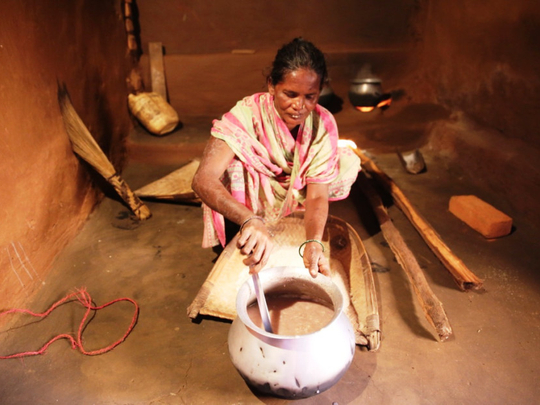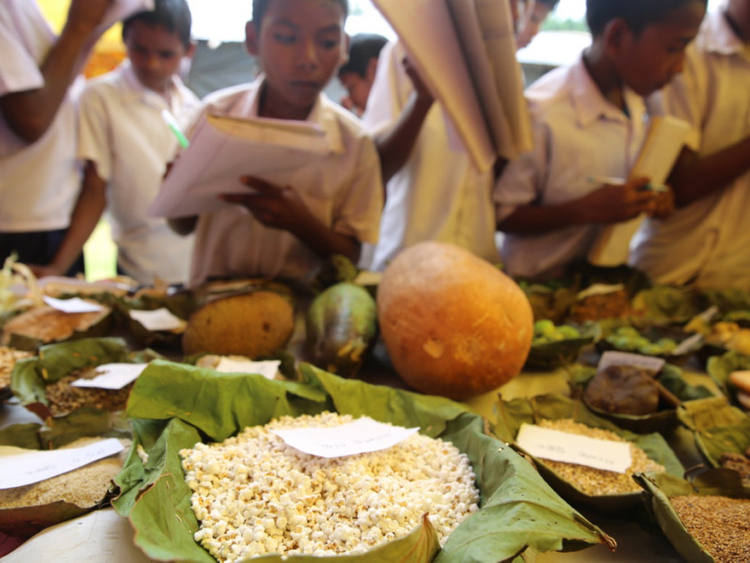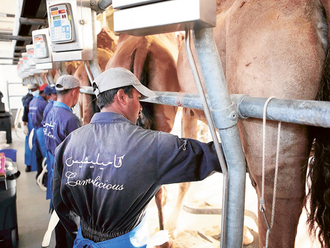
India has been ranked 97th out of 118 countries on the International Food Policy Research Institute’s (IFPRI) Global Hunger Index (GHI) in 2016, behind Nepal, Sri Lanka, Bangladesh. The report says two out of five children under five years are stunted in India. Stunting measures chronic malnutrition and affected children’s height is considerably below the average for their age. Worrying news indeed for a country that is slated to become the world’s most populous nation in just six years.
Many experts around the world are underlining the need to move from the industrial model of agriculture to small-scale, diverse community level farms, of balanced food ecosystems that do not deplete the soil and to re-introduce indigenous varieties of foods lost to monocropping. Indigenous diets have been found to be far more diverse and can check malnutrition and disease.
Here are three case studies from my travels around India that illustrate the problems underlying malnutrition, food production and how people are coming up with their own solutions without much help from the government.
Madhya Pradesh: Erosion of traditional food systems
I travelled around Shivpuri, and Sheopur areas, working with a team of German filmmakers who were shooting a documentary on hunger and food issues. The Sahariya tribe is the predominant population in these areas. The tribe has always had a diet rich in millets, forest tubers and greens, wild mushrooms, fruits and a variety of birds and animals. In fact, the diet is so rich that no urban health freak’s plate comes anywhere near its nutrition quotient.
It was startling to discover that there are alarming levels of child malnutrition among this tribal population. Studies have shown that the tribe could source around 260 items from forests, including plants and trees that were used as food, medicines, to make bread, indigenous liquor, oil, beedis, etc.
To a large extent, this rich diversity was eroded when their land was taken over for cash crops and industries, the disruption of traditional lifestyles due to environmental degradation and the introduction of processed foods, refined fats and oils, and simple carbohydrates.
Compounding the problem was that the youth were losing their identity and indigenous knowledge systems — they knew almost nothing about how to identify their ancient grains, tubers and green leafy vegetables. Many of the seeds were no longer available.
Odisha: Women bring back diversity on plates
Admai Kumruka is sifting millet in a traditional sieve made of bamboo strips. Children mill around, playing on a mud and sand mound. A few huts down from Kumruka, Rello Dindika is sorting through harvested corn.
A group of women is chopping fresh pumpkin leaves and flowers for a stir-fried dish. It is early morning in Dhepagudi, a sleepy hamlet nestled among green hills in Rayagada district, Odisha. The women have finished morning chores and farming work, and are now making preparations for breakfast.
Some of the “maka” (corn) will be ground to a powder for a wholesome porridge. The rest will made into “lia” — popped in clay vessels to be had as evening snack. The mandya (a variety of millet) will be made into upma (an Indian savoury porridge with vegetables and herbs).
“We have mandya or kosla [another variety of millet] or maka porridge in the mornings sometimes with roots and tubers or gondri saag (a variety of greens) foraged from the jungles,” says Kumruka. “In the afernoons and evenings, we make rice with tubers, vegetables and legumes. Sometimes we add wild mushrooms, or jhotta [okra], and holud [turmeric].”
The women belong to the Khond community, a large adivasi (indigenous tribal) group in India. A wide variety of millets and foraged jungle foods has been part of the rich and diverse diets of generations of Khonds. That is, until a few years ago when the forest department proposed that forest lands be used for cash crops such as teak, eucalyptus, soya and cotton.
Kumruka recounts how entire patches were taken over for plantations, and much of their indigenous green wealth disappeared. “We had so many different millets on our plates earlier,” she says, “And jungle tubers, saag [greens], mushrooms. And so many mahua trees.”
The ubiquitous mahua is central to the lives of adivasis. The waxy flowers of the trees infuse jungles with their heady fragrance. The leaves are woven into cups and plates, the oil used in traditional medicine, as hair oil, to massage newborn babies, for making soap, in cooking and for lighting lamps. The seeds, fruits and flowers are cooked, and are considered good for health. The bark relieves itching, heals wounds and snake bites. All this disappeared when plantations were introduced.
Traditionally they had grown varieties of crops through mixed-cropping practices which helped maintain soil fertility. Seeds were stored after each harvest and exchanged, ensuring the local adaptability and availability of seeds to produce several varieties of foods.
Now the villagers watched with dismay as soil fertility was eroded by manmade “forests”, designed to meet industrial requirements. Soon a diverse forest ecosystem was converted into a single species cash crop area to be “mined” for revenue purposes.
Some kilometres away, the people of Khalpadar village were experiencing something similar. Large chunks of surrounding forests had been indiscriminately cut down by the forest department to make way for cash plantations, affecting their food ethos.
When they protested, they were told that cheap rice and wheat would be available under the PDS (public distribution system) — the Indian food security system established by the government which is supposed to distribute some subsidised foods to the poor. But this could never compensate for the loss of their traditional forest trees — a vital support system for tribal communities providing them with food, medicine, fodder and fuel wood. Their diets suffered. Their children did not get enough nutrition.
The women of Khalpadar decided to resist destructive development and pave the way for a more sustainable future. Today, thanks to their efforts, these hills are flourishing with indigenous trees and plants that have brought back diversity on their plates.
“When they came to persuade us to plant eucalyptus and teak, we refused. They said ‘paisa zyada milega’ (you will get more money),” says Timoli Kurunjelika. The men, especially the young ones, were drawn by the lure of money. “But we had seen earlier that these trees suck the life out of surrounding area,” says Timoli. “No other tree can take root, no tubers, mushrooms, or fruits can grow. The soil gets damaged, too.”
The villagers had a series of meetings in their area with officials and other villages to consider how to stop the destruction of their food ethos. When officials refused to listen to them, they decided to cut down the cash plantations and plant traditional crops. “We planted dates, mangoes, jackfruit, tamarind, jaamkoli [a kind of berry],” says Balo Shikoka. They had to work hard and it took time to bring back some of the older diversity. The traditional trees take five years to grow, at least. The soil, which has been damaged by plantations, takes time to replenish.
The women became catalysts for change, telling other villagers to replant and re-grow their forests. “This year — from June to July alone — we have re-grown jungles in 35 villages in Muniguda block,” says Sukhomoti Shikoka. “About 6,000 families from Muniguda to Bissam Cuttack have got involved — each planting 10 to 15 trees.”
Soon their efforts improved the diversity of food on their plates. “We always have something to eat, unlike those in the cities who go hungry if they don’t have money to buy food,” says Shikoka.
Living Farms, an NGO working in the region on issues related to food and nutrition security, assesses dietary diversity every six months. The dietary diversity score is a parameter to measure food diversity laid down by FAO. They found the number of families with low scores was 58 per cent in 2014. Now it has reduced to 18 per cent.
Living Farms has compiled a list of forest foods and their nutritional values. With the help of trained nutritionists, they have identified 66 uncultivated foods rich in a variety of nutrients, including folic acid, iron, calcium, vitamins C, B and A, and beta carotene.
People they talked to could name more than 60 varieties of fruit (mango, wild cashew, blackberry, jackfruit, kendu, date palm and mahua, among others), 40 kinds of leafy vegetables (barada saag, gandiri saag, chakunda saag, curry leaves, colocasia leaves and drumstick leaves, to name a few), 10 kinds of oil seeds, 30 kinds of mushrooms, roots and tubers, and 20 varieties of fish, crab, insects and birds that they could collect and consume directly from the forest.
Living Farms has introduced a series of classes on indigenous foods — how to grow them, what are their uses — in some government schools in the hope that it will combat the loss of knowledge about traditional foods among tribal youth.
Most adivasi children are sent away to the nearest boarding school at an early age. Removed from the food of their milieu, they are exposed instead to a limited range of foods such as rice, wheat and even instant noodles. “Their knowledge about food is influenced by the mainstream. And by what they see in textbooks,” says Ashita Abraham, a teacher at a school. “We had a game which involved identifying names of foods they eat. The first thing they said in the game was ‘bhaato’ — rice.”
The Sundarbans: Weathering climate change
Sundarbans, the vast mangrove delta straddling India and Bangladesh, is the largest of its kind in the world and a Unesco heritage area. Organisations, including the Intergovernmental Panel on Climate Change (IPCC), have warned that areas such as the Sundarbans will bear the brunt of climate change due to rising sea levels.
The region’s residents are struggling to cope. Apart from rising seas, they face erratic weather, increasingly severe floods, heavy rainfall and cyclones. The frequent incursion of saline water has affected the quality of soil and groundwater.
In Hingalganj, close to the Bangladesh border, the effects of salination are visible in the vast stretches of dry and cracked land. “Aila just destroyed our land,” says Potit Mondal. He is referring to the May 2009 cyclone that affected nearly four million people in India and Bangladesh. More than 200 people died, huge numbers of livestock were lost, roads were destroyed and crops were wiped out. The floods devastated both homes and low farmlands, leaving the area waterlogged for many months.
Post-Aila soil tests carried out by the European Commission of Humanitarian Aid (ECHO) found salinity had reached a depth of about 1.5 metres in most areas. But some farmers are rebuilding their lives by working in tune with nature, switching from the modern high-yield paddy seeds to native saline-resistant varieties such as Dudheswar, Nonasree and Hogla.
These were in use earlier before large-scale, commercial agriculture, fertiliser and seed companies took over. Planting hardy native crops, using integrated farming methods and banking seeds are effective counter-measures against the threat of starvation caused by natural disasters, land erosion and high soil salinity.
The seeds and training in integrated farming methods were sponsored by the Development Research Communication and Services Centre (DRCSC), a non-government development organisation in West Bengal that focuses on sustainable agriculture, disaster and climate change adaptation. “DRCSC has been giving out desi [indigenous] varieties of seeds that can withstand salinity levels, but we have limited resources,” says Chinmoy Mukherjee, who lives in Hingalganj and works with the DRCSC. “There are 350 families here. We work with 40.”
They work mostly with women whose husbands have migrated in search of alternative livelihoods, leaving them behind to take care of family and farm.
Champa Munda has two daughters and one son. Her husband is in Kolkata most of the year, working in the construction sector. “He visits every two months, stays for a couple of days and is gone again,” she says. Munda is one of the many women in the Sundarbans who are doing housework, caring for children and toiling on farms. She raises goats and other animals, which sell for about $70 (Dh257) in the market.
In Nebukhali village in Hingalganj, several women are practising integrated farming systems to ensure survival. This involves bringing together the household, livestock and farm in a holistic, self-sustaining cycle. Staple crops are mixed with other plants and livestock. Waste from one area becomes an input for another. Proponents say the system virtually replicates systems found in nature.
In Hingalganj, women have begun the process by first reshaping the low lying lands which were used to trap water to grow commercial paddy. A pond is excavated in one area, and the dug out soil is used to raise nearby areas to grow vegetables. The pond has ducks and fish (the ducks give eggs and their excreta becomes feed for the fish). A biogas plant uses dung from farmers’ cattle as fuel, cooking gas and as manure. They also conserve beneficial insects and worms that are good for the soil. They identify and grow several nutritient-rich cultivated and uncultivated plants such as betho, a highly nutritious edible weed. These are popularised through seed exchanges, farmers fairs, etc.
Water for the crops remains a problem as most sources in this village were contaminated during Aila. However, some villages have begun rainwater harvesting projects that have improved access to fresh water.
Women have also established grain banks to store excesses — security for a rainy day, and relief from debts or huge interests. The grain bank or “gola” is essential for the food security of households. It is built on an elevated platform — generally on a concrete one — to protect stored grains from rodents and other pests, floods and storms. It consists of large baskets with tightly woven bamboo, straw and mud. Everyone has to contribute a portion of their harvest. A matching contribution is made by DRCSC’s area resource training centres to start off the bank.
Seed banking is another protective measure against climate change wherein women collect and preserve indigenous seeds, using wood charcoal and neem oil. These are then banked in earthen pots and glass jars. In seed fairs around India, farmers share. Munda sees reasons for hope in her newly acquired knowledge about farming. “I feel we are better prepared better now that we have the knowledge to regenerate our soil.”
Anuradha Sengupta is a writer based in Mumbai.














